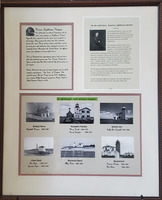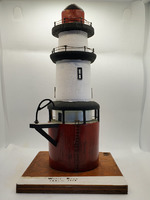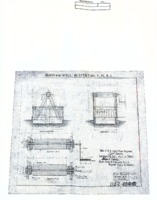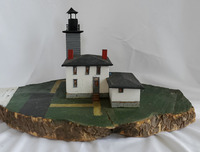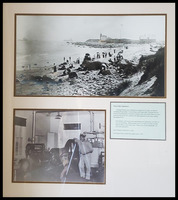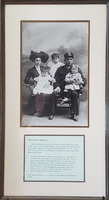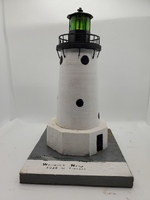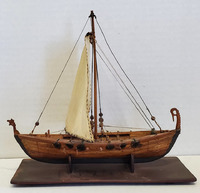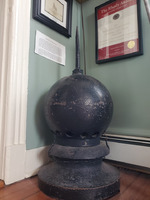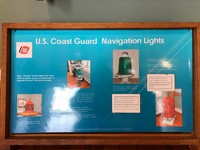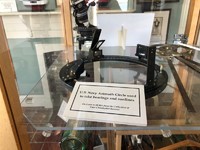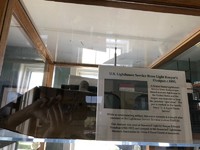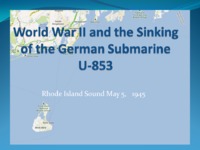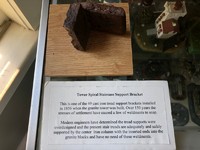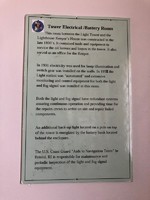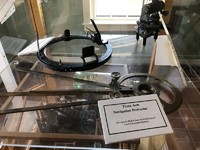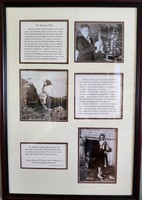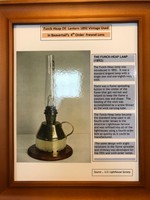Browse Items (246 total)
Sort by:
Women Lighthouse Keeper's
There were many woman lighthouse keepers in RI Lighthouses
Bristol Ferry, Newport Harbor, Watch Hill, Lime Rock, Warwick Neck, and Beavertail had women keepers.
Tags: Sullivan Room, West Wall
Whale Rock Lighthouse - Model
This lighthouse was built in 1882, standing at 71ft tall with a fixed red character. It is located at 41 degrees North and 71 degrees West on Whale Rock with a bell for its fog signal. Whale Rock was maintained for 56 years until it was discontinued…
Tags: Dennis Model, East Wall, Sullivan Room
Watch Hill Lighthouse - Model
This lighthouse was built in 1807, standing at 62ft tall with a fixed white character. It is located at 41 degrees North and 71 degrees West on Watch Hill Point with a horn for its fog signal.
Tags: Dennis Model, East Wall, Sullivan Room
Watch Hill Lighthouse
Richard Fricke was a lighthouse keeper for 27 years at stations including Point Judith, Latimer Reef, and Watch Hill. Richard and his stepson, Fred Buckley, received a citation from the United States government for the rescue of a canoeist who had…
Tags: South Wall, Sullivan Room
Warwick Neck Lighthouse
May Chrietzbert was born in the Warwick Neck lighthouse in 1913, shortly after her father, Jorgen Bakken, became keeper. She and her sister, now Madeline Wright, grew up near the old lighthouse. In 1932, erosion threatened to undermine the building.…
Tags: Sullivan Room, West Wall
Warwick Light - Model
The lighthouse was built in 1826, and then rebuilt in 1932, standing at a height of 54ft with a fixed white character. It is located at 41 degrees North and 71 degrees West with a siren for a fog signal.
Tags: Dennis Model, East Wall, Sullivan Room
Viking Ship Model
Craftsman and Date Unknown
Donated to BLMA by David Macdonald, Weymouth, MA 2019
Tags: Middle of the Room, Sullivan Room
Vent Ball with Spire
This cast iron vent ball is typical of the standard vent balls used on Lighthouses. The purpose of the vent ball was to allow circulation of air up through the light tower through the lantern room and out through the bottom of the vent ball. A series…
Tags: Lens Room
Users of the Light
Wall panel providing illustrations, photos, and commentary regarding the various vessels and activities that rely on the continuing operation of Beavertail and other Light Stations
Tags: Theater Room
USCG Navigation Lights Poster
A poster depicting the various navigation lights on display in the Lens Room at Beavertail Lighthouse Museum.
Tags: In front of North Wall, Lens Room, lensroom
U.S. Navy Azimuth Circle
This navigation tool was used to take bearings and sunlines.
It is on loan to BLMA from the Collection of Captain Christopher Karentz.
Tags: Middle of the Room, Sullivan Room
U.S. Lighthouse Service Brass Lighthouse Keeper's Dustpan
The brass dustpan was an essential tool used to keep the lighthouse "spot clean". Many were marked with "U.S. Light House Service".
This dustpan was donated to BLMA by Teresa & David Emond of Jamestown and was originally used by Keeper Edward…
Tags: Middle of the Room, Sullivan Room
Tower Spiral Staircase Support Bracket
This is one of the 49 cast iron tread support brackets installed in1856 when the present tower was built. Over 150 years the stresses of settlement have caused a few of the weldments to snap.Modem engineers have determined that the tread supports…
Tags: Inactive Room, Interactive Room, West Wall
Tower Electrical/Battery Room
This room between the Light Tower and the Lighthouse Keeper’s House was constructed in the late 1800s. It contained tools and equipment to service the oil lantern and lenses in the tower. It also served as an office for the Keeper.
In 1931…
Tags: South Wall, Tower Room
Three Arm Navigation Protractor
This navigation tool is on loan to BLMA from the Collection of Captain Christopher Karentz.
Tags: Middle of the Room, Sullivan Room
The Funck-Heap Lamp
This lamp was introduced in 1892. It was the standard lamp that was used in the 4th Order lenses in many lighthouses. It was a standard "Argand lamp" with a single 1 1/8 inch wick.
With a few alterations, the same lamp was used for the 5th and 6th…
Tags: Lens Room, lensroom, North Wall


